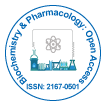
Biochemistry & Pharmacology: Open Access
Open Access
ISSN: 2167-0501

ISSN: 2167-0501
Perspective - (2025)Volume 14, Issue 1
The use of medicinal plants for the management of diabetes mellitus has drawn substantial attention in recent years due to the rising global prevalence of the disease and the limitations associated with conventional therapeutic agents. Diabetes mellitus, particularly type 2, is a complex metabolic disorder characterized by chronic hyperglycemia and insulin resistance, often accompanied by dyslipidemia, oxidative stress and inflammation. Medicinal plants, long used in traditional medicine systems like Traditional Chinese Medicine (TCM), Ayurveda and Unani, are known to harbor a rich repository of phytochemicals with promising anti-diabetic properties. These bioactive compounds include alkaloids, flavonoids, phenolics, glycosides, terpenoids, tannins and saponins, many of which have been shown to exert glucose-lowering effects through diverse mechanisms such as enhancement of insulin secretion, improvement in insulin sensitivity, inhibition of carbohydrate-digesting enzymes and modulation of glucose uptake in peripheral tissues.
Several plants have gained prominence due to their robust phytochemical profiles. For instance, bitter melon contains charantin, polypeptide-p and vicine, compounds with insulin-like properties. Similarly, fenugreek seeds are rich in 4-hydroxyisoleucine, which stimulates insulin secretion and galactomannans, which delay carbohydrate absorption. Gymnema sylvestre has been referred to as "sugar destroyer" due to its gymnemic acids that suppress sweet taste perception and help regenerate pancreatic β-cells. Flavonoid-rich extracts from holy basil and jamun have been demonstrated to possess hypoglycemic and antioxidant effects, making them suitable candidates for adjunctive diabetes therapy.
From a biochemical perspective, phytochemicals act on multiple metabolic pathways. Flavonoids and phenolic acids possess antioxidant properties, neutralizing reactive oxygen species that contribute to β-cell dysfunction and insulin resistance. Saponins and alkaloids can modulate glucose transporters such as GLUT4 and enhance AMP-activated protein kinase activity, thus improving glucose uptake and energy metabolism. Certain terpenoids inhibit protein tyrosine phosphatase 1B, an enzyme that negatively regulates insulin signaling, thereby enhancing insulin receptor activity. Additionally, phytochemicals like berberine, derived from Berberis aristata, influence gut microbiota and increase GLP-1 secretion, offering a gut-endocrine mechanism of glycemic regulation.
The pharmacological efficacy of these plant-derived compounds has been confirmed in various in vivo and in vitro studies. Animal models of type 2 diabetes, such as streptozotocin-induced diabetic rats, have shown improved glycemic control and lipid profiles upon administration of specific plant extracts. Clinical trials, though fewer in number, have demonstrated significant improvements in fasting blood glucose, HbA1c and insulin sensitivity in patients treated with standardized herbal formulations. Importantly, these natural remedies generally exhibit fewer side effects compared to synthetic drugs like sulfonylureas or thiazolidinediones, making them appealing for long-term use.
However, despite the promising findings, there are several challenges in translating these phytochemicals into mainstream therapeutics. The variability in phytochemical content due to differences in plant species, growth conditions and extraction methods can impact reproducibility and efficacy. Moreover, the bioavailability of many phytochemicals is limited due to poor solubility or rapid metabolism. Advances in nanotechnology, such as phytochemical-loaded nanoparticles and liposomes, are being explored to overcome these issues and enhance drug delivery. Furthermore, rigorous pharmacokinetic, pharmacodynamic and toxicological studies are essential to establish safe dosage regimens and minimize potential herb-drug interactions.
In conclusion, phytochemicals derived from medicinal plants offer a valuable reservoir of anti-diabetic agents that function through multiple mechanisms, including insulin mimicking, glucose uptake modulation, oxidative stress reduction and enzyme inhibition. Their multifactorial actions not only address hyperglycemia but also target the underlying pathophysiology of diabetes, such as inflammation and oxidative damage. While further research is necessary to standardize preparations and confirm clinical efficacy, the integration of phytochemicals into diabetes management holds significant promise, particularly in resource-limited settings where access to conventional medications may be restricted. With continued interdisciplinary collaboration between ethnobotanists, pharmacologists and clinical researchers, these natural compounds could contribute substantially to the global fight against diabetes.
Citation: Wei J (2025). Phytochemical Constituents of Medicinal Plants as Potential Anti-Diabetic Therapeutics: Biochemical and Pharmacological Insights. Biochem Pharmacol.14:387.
Received: 03-Feb-2025, Manuscript No. BCPC-25-37581 ; Editor assigned: 05-Feb-2025, Pre QC No. BCPC-25-37581 (PQ); Reviewed: 19-Feb-2025, QC No. BCPC-25-37581 ; Revised: 26-Feb-2025, Manuscript No. BCPC-25-37581 (R);; Published: 04-Mar-2025 , DOI: 10.35248/2167-0501.25.14.387
Copyright: © 2025 Wei J. This is an open-access article distributed under the terms of the Creative Commons Attribution License, which permits unrestricted use, distribution, and reproduction in any medium, provided the original author and source are credited.